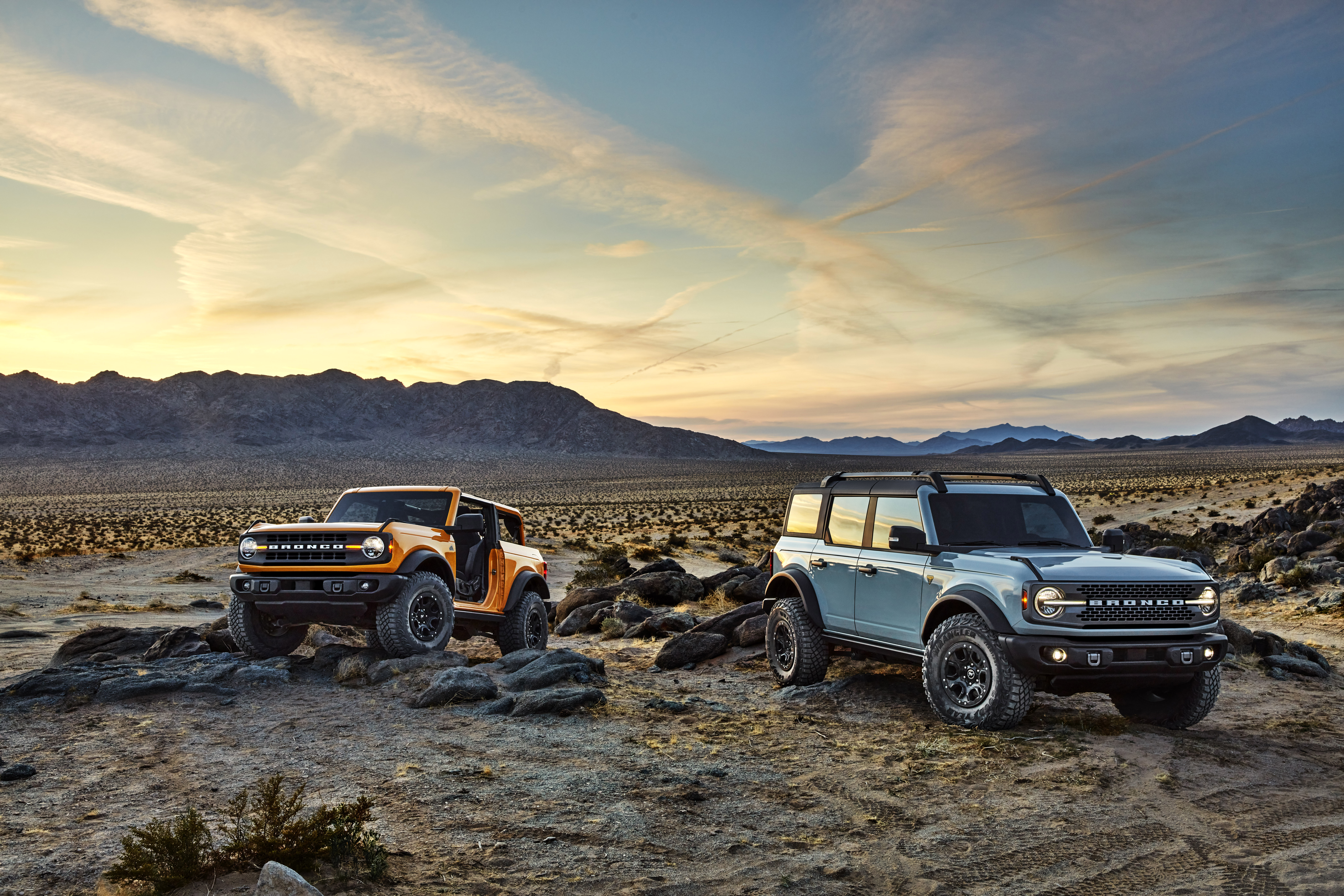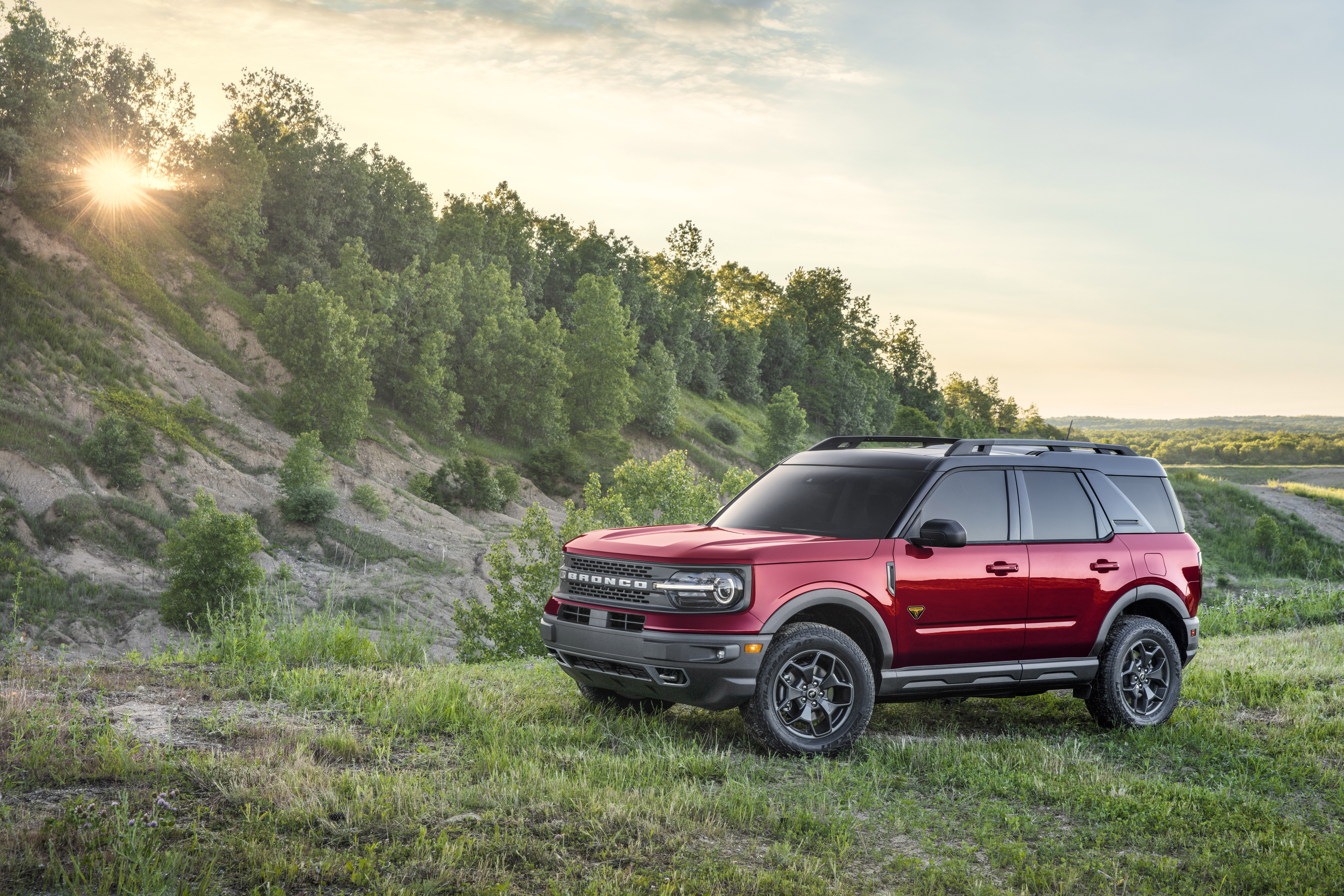TechCrunch
TechCrunch
The Bronco 2021 — Ford’s flagship series of 4×4 vehicles — is a brand that leans heavily on nostalgia, customization, functional design and technology such as the automaker’s next-generation infotainment system and a digital trail mapping feature that lets owners plan, record and share their experiences via an app.
This is not the 1966 Ford Bronco, the first year that the rugged two-door off-roader came to market to compete with the Jeep CJ-5. However, the DNA from that heritage model is present in this modern take of the Bronco 2 as well as a new four-door version. The third model, the Bronco Sport, is a comfier, smaller snd cheaper spinoff that is designed to be capable off-road as well as function as a daily driver on the city streets and highways.
Production on the new Bronco 2 and Bronco 4 will begin in early 2021 with the first models arriving in dealerships next spring. The Bronco Sport is slated to reach dealerships later this year. All three of Bronco models will be built at Michigan Assembly Plant in Wayne, Michigan. Ford has also opened up reservations, where prospective customers can plunk down $100 to hold their spot for the Bronco two- and four-door models.
The base model Bronco 2 starts at $29,995 and the Bronco 4 starts $34,695. The base version of the Bronco Sport starts at $28,155. (all prices include the including $1,495 destination and delivery charge)
There’s a lot to unpack here. Let’s start with the basics of the Bronco two-door and Bronco four-door vehicles as well as the smaller Bronco Sport. Then we’ll dig deeper into some important themes including nostalgia, design, customization and technology.
Bronco 2 and Bronco 4

Pre-production versions of the 2021 Bronco, shown here, include Bronco two-door in Cyber Orange Metallic Tri-Coat and Bronco four-door in Cactus Gray. Photo: Ford
Both models have a steel chassis and an independent front suspension, the aim here being to improve control. At the rear, the solid axle design features coil springs with five locating links to provide control off road and strength. The vehicles come with two possible engines — a 2.7-liter V6 or 2.3-liter four cylinder— and are available in 7-speed manual and 10-speed automatic transmissions. The 2.7-liter EcoBoost V6 engine is projected to produce 310 horsepower and 400 lb.-ft. of torque, while the 2.3-liter four cylinder engine has torque of 310 lb.-ft. with an expected 270 horsepower. No word yet on gas mileage.
Ford gave Bronco 11.6-inch ground clearance, a 29-degree breakover angle and 37.2-degree departure angle. It also has water fording capability of up to 33.5 inches. Just to be safe, Ford designers added more protection and heft, including modular steel bumpers with integrated winch mount. Some of the higher-end versions of the Bronco comes with steel shields to protect critical hardware, including the engine, transmission, transfer case and fuel tank.
Oh, and how could I forget. Ford is making 35-inch off-road tires available in every trim level on the Bronco 2 and Bronco 4.
Bronco Sport
Meanwhile, the Bronco Sport is a slightly different animal aimed to be that go everywhere and do everything family truckster. The Sport offers a lot of the same off-road capability in a smaller package.
The Bronco Sport has two EcoBoost engines to choose from, depending on the trim. There’s a 2.0-liter engine that produces 245 horsepower and 275 lb.-ft. of torque or a 1.5-liter engine with a targeted 181 horsepower and 190 lb.-ft. of torque. Both engines are paired with an 8-speed automatic transmission. Certain trims of the Bronco Sport also come with steering wheel-mounted paddle shifters.
The vehicle also has a Safari-style roof that provides enough space to put two bikes in the back. The vehicle also has the flip-up liftgate glass, a convenience detail that lets you quickly throw gear back into the vehicle. The five trims levels are base, Big Bend, Outer Banks, Badlands and First Edition and have starting prices that range between $28,155 all the way to $39,995.
Digging deeper into the family of Bronco vehicles a few themes emerge, particularly with the Bronco 2 and Bronco 4. The vehicles are meant to remind us of the original while pushing forward to the future. They’re designed to be rugged and institute modern human-centered functional design, while embracing technology in some key areas.
Nostalgia

Pre-production 2021 Bronco two-door SUV takes its design cues from the first-generation 1966 Bronco.
While technologists might cast a bit of side eye at nostalgia, there’s no denying its power. As TechCrunch’s Matt Burns noted last week Ford is going to use the old Bronco to sell the new Bronco, just like Nintendo uses past games to sell new games.
The 2021 Bronco 2 is clearly new, particularly once you look inside. But glancing over the exterior it’s hard to miss inspirations from the original.
The Bronco 2 and Bronco 4 has square proportions, short overhangs and a wide stance, all aspects that make these vehicles primed for off roading. They also harken back to the original design. From the side, you’ll notice distinct edges and flared fenders, again a nod to the first Bronco.
Customization
Here’s where the 2021 Bronco series really shines. Ford has comes up with innumerable ways to customize the Bronco 2 or Bronco 4 and even the Bronco Sport.
The automaker is offering seven different versions of the Bronco 2 and Bronco 4 with matching color and trim combinations. There are also 11 different paint choices and four content package. The options begin with the base no-frills version and ends with the Wildtrak and Badlands versions for for more extreme off-road adventuring. The Big Bend, Black Diamond and Outer Banks sit in the middle. And of course, there’s a limited-production First Edition that will be offered at launch. The base models of all three Broncos fall under $35,000. But that price starts to rise as with the trim levels and other options.
The automaker also has more than 200 factory-based accessories.
The Bronco 2 and Bronco 4 are meant to be configured in multiple ways. For instance, the Bronco 2 models come with a standard three-section roof system. There’s also premium-painted modular top with four sections that adds a removable panel over the rear seats and cargo area.
The Bronco 4 has four removable roof sections, all which Ford promises can be removed by one person by unlocking the latches from the interior. The models are also available in soft or hardtops, or can be optioned with both. Even the large open wheel wells are a modular design with a quick-release attachment for customization.
The doors of the Bronco 2 and Bronco 4 can also be removed. The doors are frameless, a design decision that aims to make them easy to remove and store in protective bags. The Bronco 4 is large enough to store all four doors onboard.
All of those options come with a price, however. The most expensive trim level, the First Edition hits just below $60,000.
While it might not have the same degree of customization as the Bronco 2 and Bronco 4, there are plenty of ways to configure the Bronco Sport as well.
The vehicle is available in five trims, including the base model, Big Bend, Outer Banks, Badlands and First Edition as well as four available accessory bundles. Ford is offering more than 100 factory-backed standalone accessories to transport a variety of gear including kayaks, skis and camping equipment.
Technology
Much of the technological focus is on the four-wheel drive system and is at the heart of the brand’s so-called Terrain Management System.
Ford is offering two different 4×4 systems on all Bronco models, a base setup and an advanced system. The base system uses a two-speed electronic shift-on-the-fly transfer case. The optional advanced system has a two-speed electromechanical transfer case that adds an auto mode for on-demand engagement that lets the driver select between 2H and 4H (two high and four high). The Bronco 2 and Bronco 4 have up to seven driver-selectable modes for off-road driving, including Normal, Eco, Sport, Slippery and Sand, with Baja, Mud/Ruts and Rock Crawl.
There is other technology in the vehicle beyond the 4×4 system. The Bronco 2 and Bronco 4 comes with the next-generation Ford SYNC 4 infotainment system and a feature that stores more than 1,000 curated topographic trail maps that are accessible online or offline. The maps can also be shared with others.
The infotainment system features a multifunction color LCD instrument panel that Ford says were inspired by the first-generation Bronco. The SYNC 4 infotainment system, which has twice the computing power of the previous generation, includes an 8-inch or 12-inch center display and features natural voice control, real-time mapping and will be able to be updated wirelessly just like the software on your smartphone. The SYNC system also displays an optional 360-degree camera system that gives drivers “spotter” views of the vehicle, a feature that could come in handy while in technical off-roading situations like rock crawling.
Moving down from the center display, the driver can interact with the transmission shifter/selector and G.O.A.T. Modes controller (off road modes) in the center console.

Customization details include an available leather-wrapped shift lever for the 7-speed manual transmission, as well as grab handles. Image Credits: Ford
Grab handles are actually integrated into the modular instrument panel and center console for those Oh S—T moments (obviously for the passenger).
Ford also included attachment points that are built into the instrument panel to mount pretty much any device you might want, including cameras, navigation units, phones or other devices.

The instrument panel in the 2021 Bronco two- and four-door models is ready for installation of accessories such as a bring-your-own-device rack shown on this prototype. Image Credits: Ford
Design
Another big piece of the Bronco 2 and Bronco 4 is the focus on functional design. This is meant to be an off road vehicle, after all. And it should function as such.
For instance, the trail sights on the front fenders also can be used as tie downs and can handle longer items like canoes. Those trail sights are placed so a user can tie off a boat or other equipment without scratching the paint or lights. But they can also be taken off or replaced with other gear, Bronco chief designer Paul Wraith noted in a briefing before the reveal.
“You can swap them out or bolt on extra lights or Go Pros,” Wraith said. “And, especially if you’re shorter, you can simply use them to tell you where the corners of the truck are, which just goes to show that innovation doesn’t always need a microchip.”
And as mentioned above, the interior is also designed with an accessory-hungry owner in mind. Other design features include a floor drain and flooring material on select models, hooks on the back seats for lashing down gear while on the road and a slide-out rear tailgate.
Want more photos? OK, click the gallery. (All photos from Ford).
]]>








